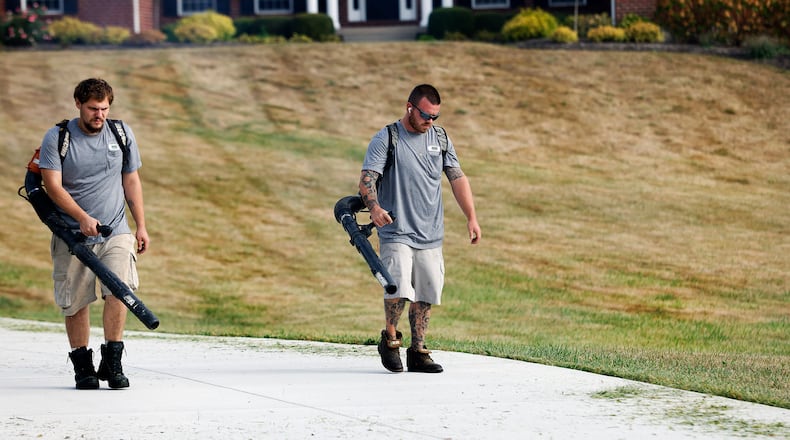“(The drought has) definitely impacted business quite a bit,” said Sabrina Dunham, co-owner of Dunham’s Lawn Care. “All the lawns are very brittle and dried up. A lot of the plants are also struggling.
“When things are looking rough outside, I don’t think people are really trying to invest anymore in their landscaping,” she said.
Janelle Harron of Xenia said her property is the most dry it has looked since she first moved in 20 years ago.
She contracts out to a landscaping company on annual basis to maintain seven of her 16 acres over the course of the year, but those services were not needed at all last month and for much of this month.
“They haven’t even been able to come out and do anything,” Harron said. “It was too brown — everybody’s was — and it didn’t need mowed.”
Despite recent rain, the lawn remained dry and brown this past week. In addition, her garden has seen better days.
“I didn’t get to enjoy my flowers as much as I have in the past, but this is just a season,” Harron said.
Rain totals can vary within a county or city depending on isolated storms. But according to National Weather Service data, the Miami Valley got no more than 0.01 inches of rain in the 34 days between Aug. 19 and Sept. 21.
Dunham said it hasn’t been this dry and this concerning in about 15 years. That dryness has meant a transition in the types of services earlier than planned, she said.
“Usually, we’re able to do a lot of planting, even through the cooler fall months, but because it’s been so hot and dry, we’re getting more requests for scheduling leaf services, more requests for firewood versus a lot of the planting that we typically do in the fall,” Dunham said. “With the dryness, the trees are really stressed, and so the leaves are falling a little bit quicker than they have in years past.
“We also have some folks that are scheduling for snow already, which is ... a little bit earlier than we have experienced this in years past.”
What the business isn’t getting is calls for mowing when few are mowing their grass.
“It definitely has slowed down quite a bit on that,” she said. “We have a pretty full mowing route, and the guy or crew or team, they’re getting done a lot earlier each day.”
Dunham said a few days worth of rain will help area landscaping and lawns “a little bit,” but not enough to restore them to the lush, green state they attained in previous years.
While fall is normally a good time for seeding and planting, much of that business has also dried up, Ryan Dunham said.
“I think a lot of people have been holding back on that, just because they don’t want to put new plants in and put grass seed in when it’s been so dry because they don’t want to risk it, spending the money on it and dying,” he said.
Sabrina Dunham said it helps when customers are on a maintenance plan, where things can be taken care of throughout the year to help keep a property looking healthy and flourishing in the fall.
“Usually that involves core aeration and overseeding,” she said. “Being on a fertilizing plan, or a treatment plan, also helps to keep your yard healthy and (get) that lush look, and then, in the spring, you know, seeding also helps with the growth and health of the yard, too.”
Dean Brown, co-owner, manager and part of the third generation at family-owned A. Brown & Sons Nursery in Montgomery County’s Clay Twp., said that he has only seen a few summers as dry as this summer during his more than four decades on the property.
He said the business was fortunate to receive as much rain as it did before the drought started affecting Southwest Ohio in August. Once that occurred, the nursery had to increase by approximately 15% the amount of water it used to maintain the health of the nursery’s shade and ornamental trees, evergreens, shrubs and select perennials.
As the amount of precipitation dropped to zero for weeks on end, business started to slow to a trickle, as well.
“When it when it gets hot and dry, people are less likely to plant plants because it is more difficult,” he said. “The ground is harder, and it’s going to maybe increase their water bill if they have to water more, so they usually wait until right now when it’s cooler and and (there’s) more moisture.”
About the Author


